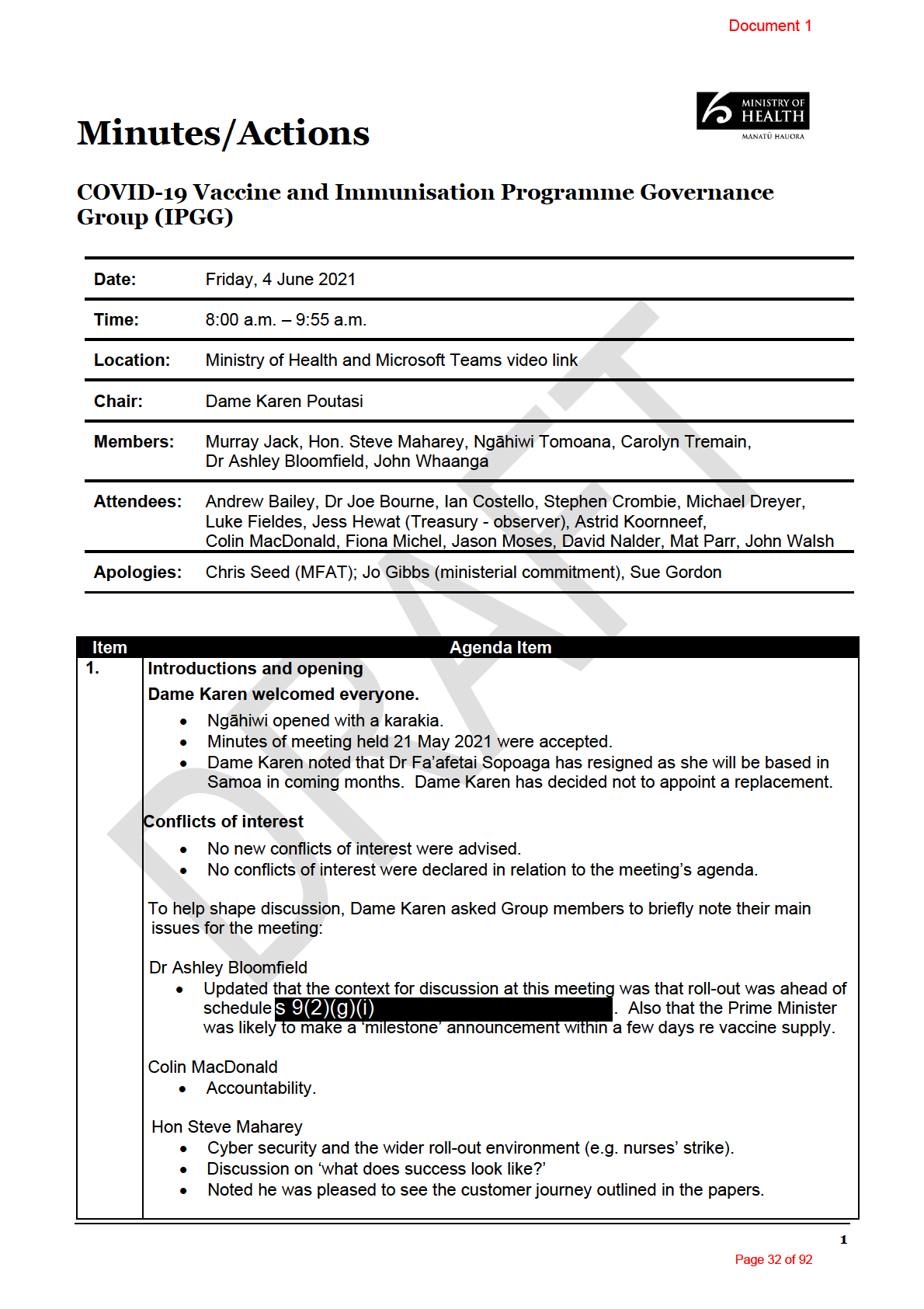
1982
ACT
INFORMATION
OFFICIAL
THE
UNDER
RELEASED
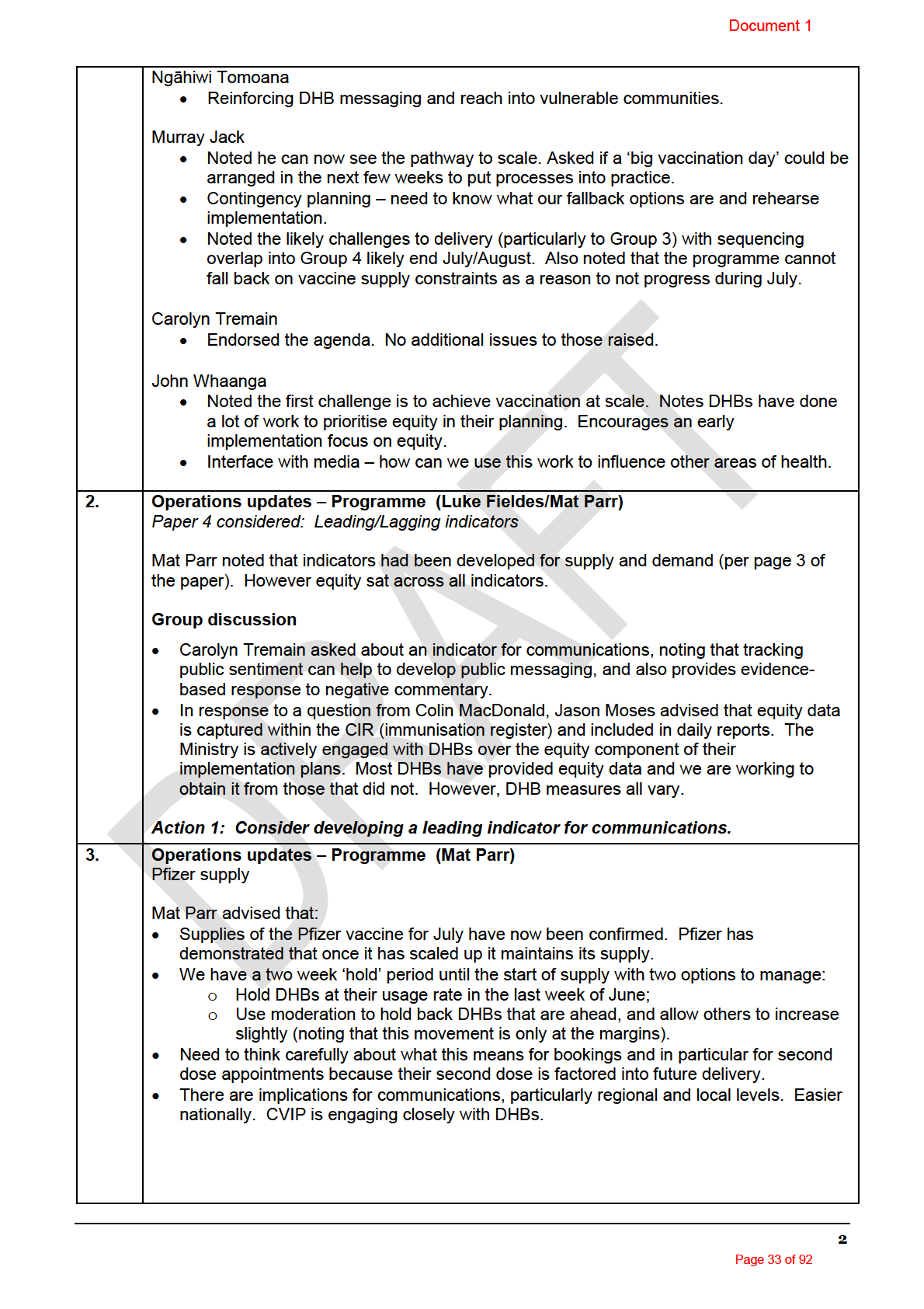
1982
ACT
INFORMATION
OFFICIAL
THE
UNDER
RELEASED
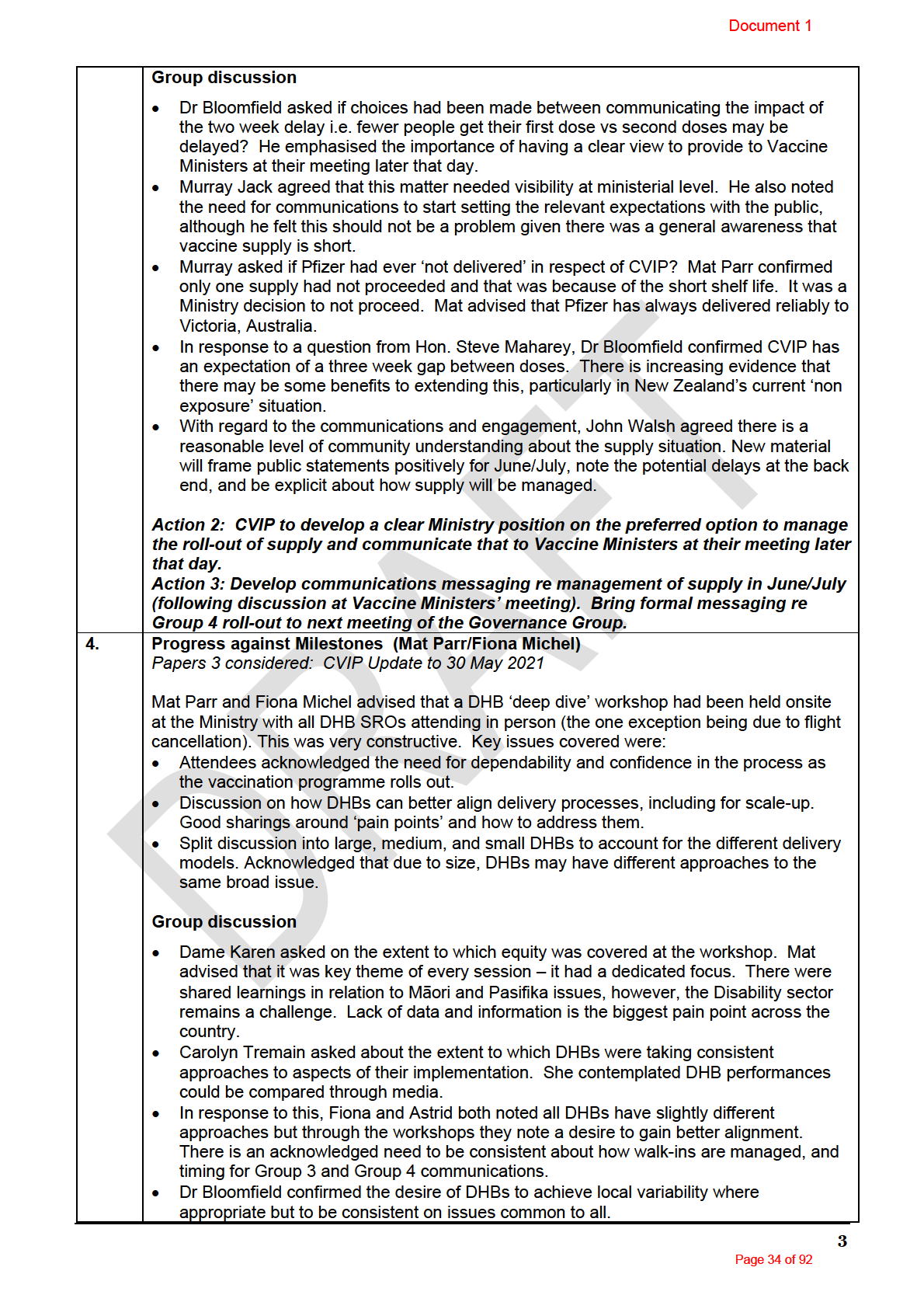
1982
ACT
INFORMATION
OFFICIAL
THE
UNDER
RELEASED
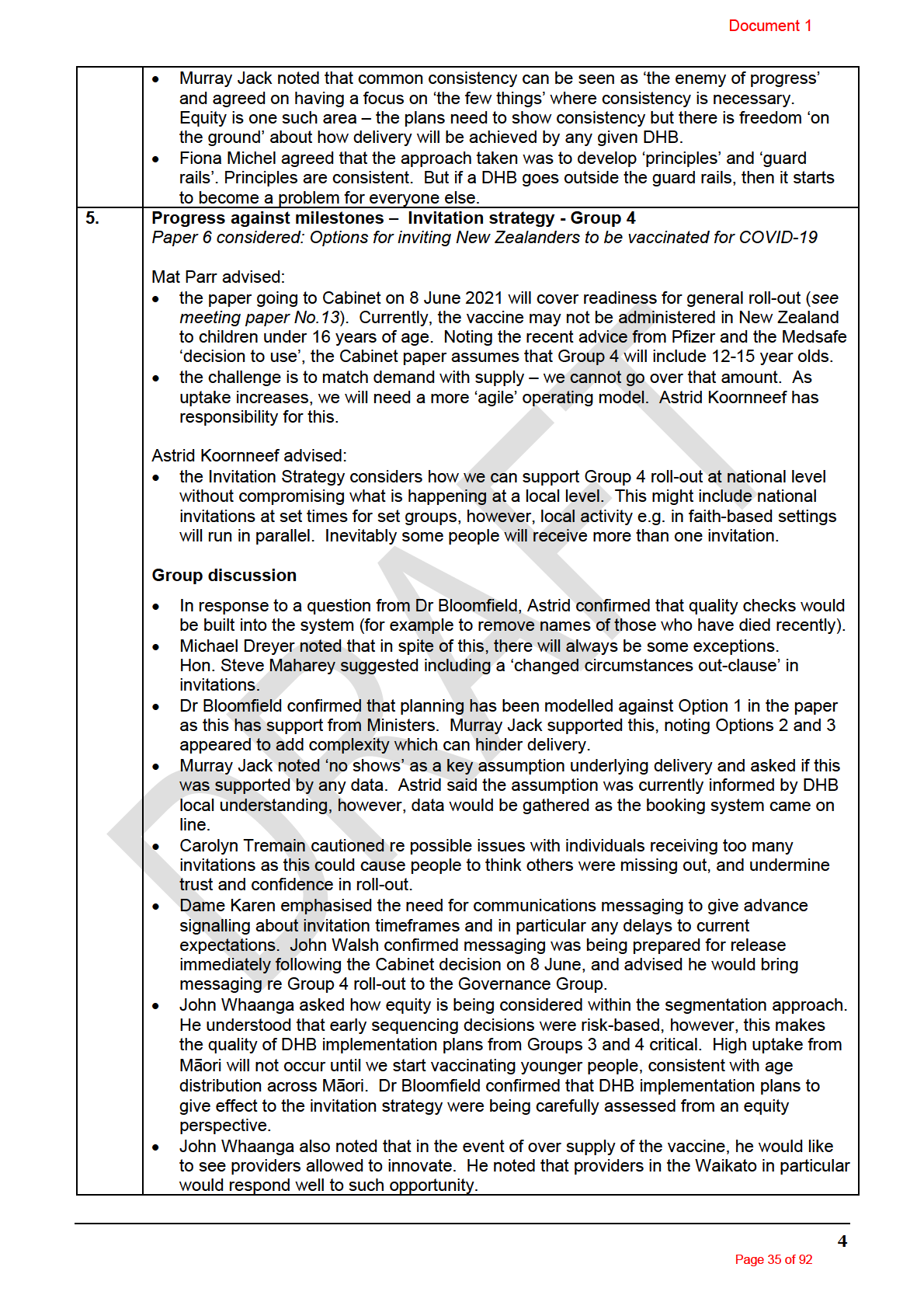
1982
ACT
INFORMATION
OFFICIAL
THE
UNDER
RELEASED
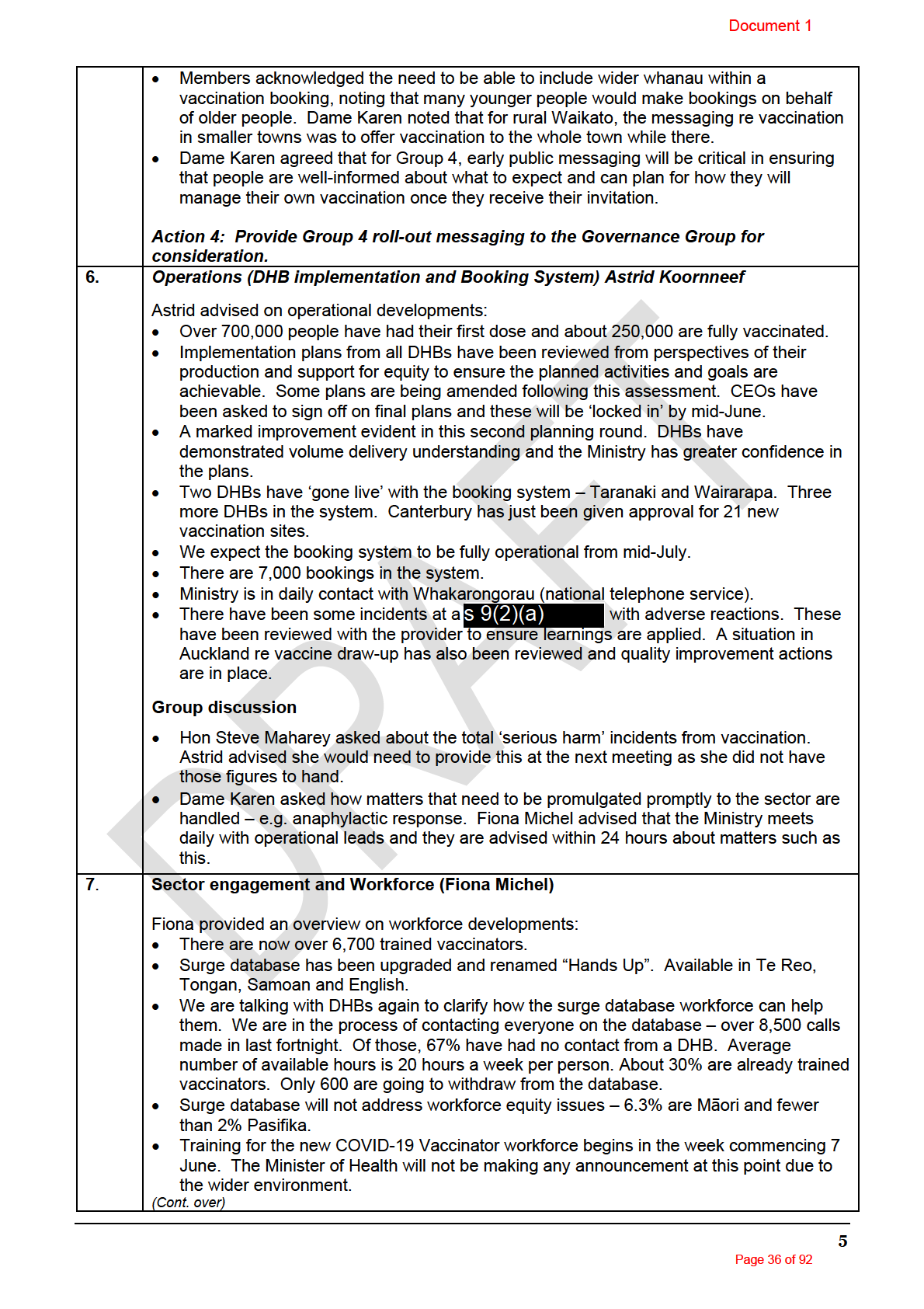
1982
ACT
INFORMATION
OFFICIAL
THE
UNDER
RELEASED

1982
ACT
INFORMATION
OFFICIAL
THE
UNDER
RELEASED

1982
ACT
INFORMATION
OFFICIAL
THE
UNDER
RELEASED
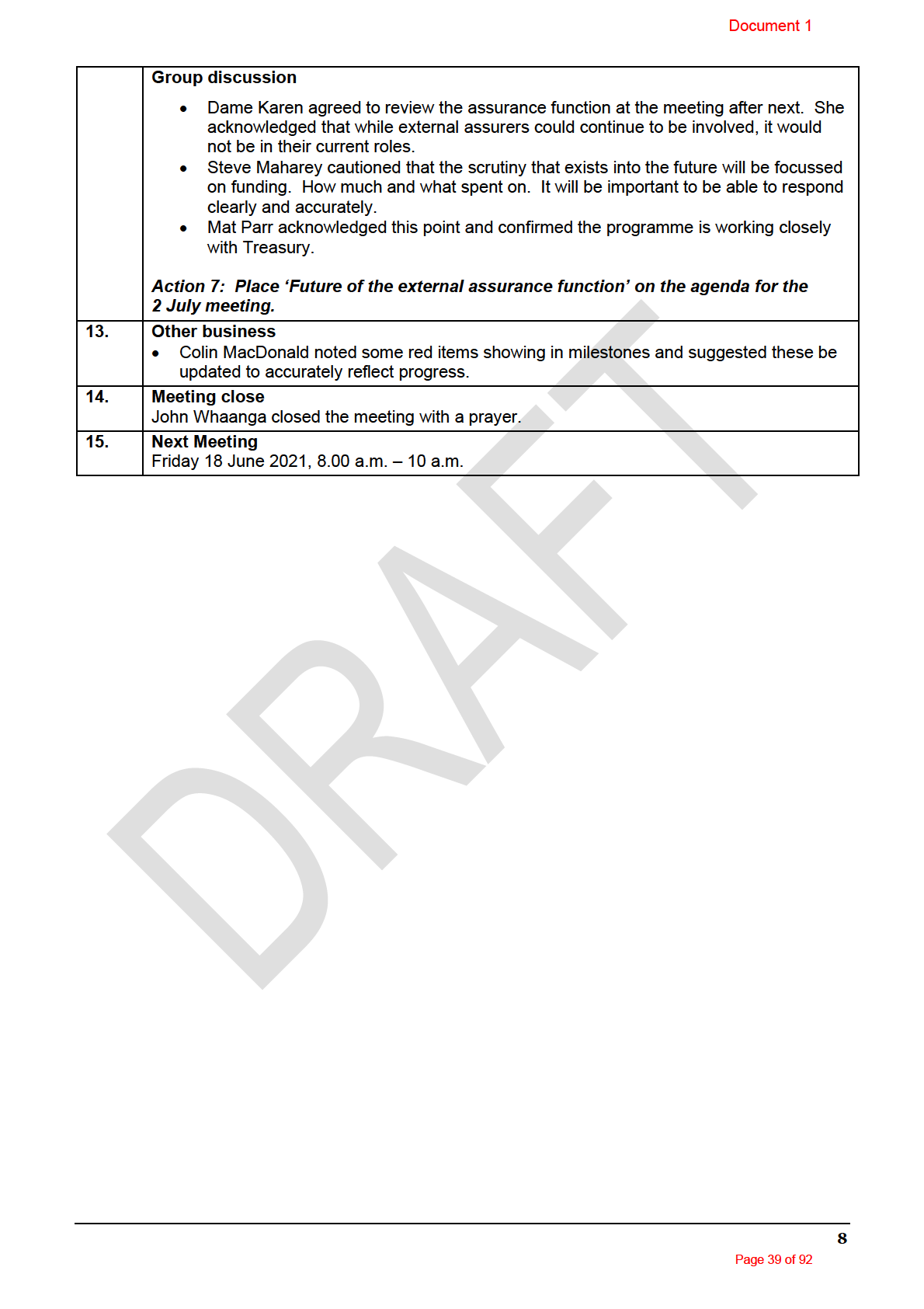
1982
ACT
INFORMATION
OFFICIAL
THE
UNDER
RELEASED
Document 1
Out of scope
1982
ACT
INFORMATION
OFFICIAL
THE
UNDER
RELEASED
Page 40 of 92
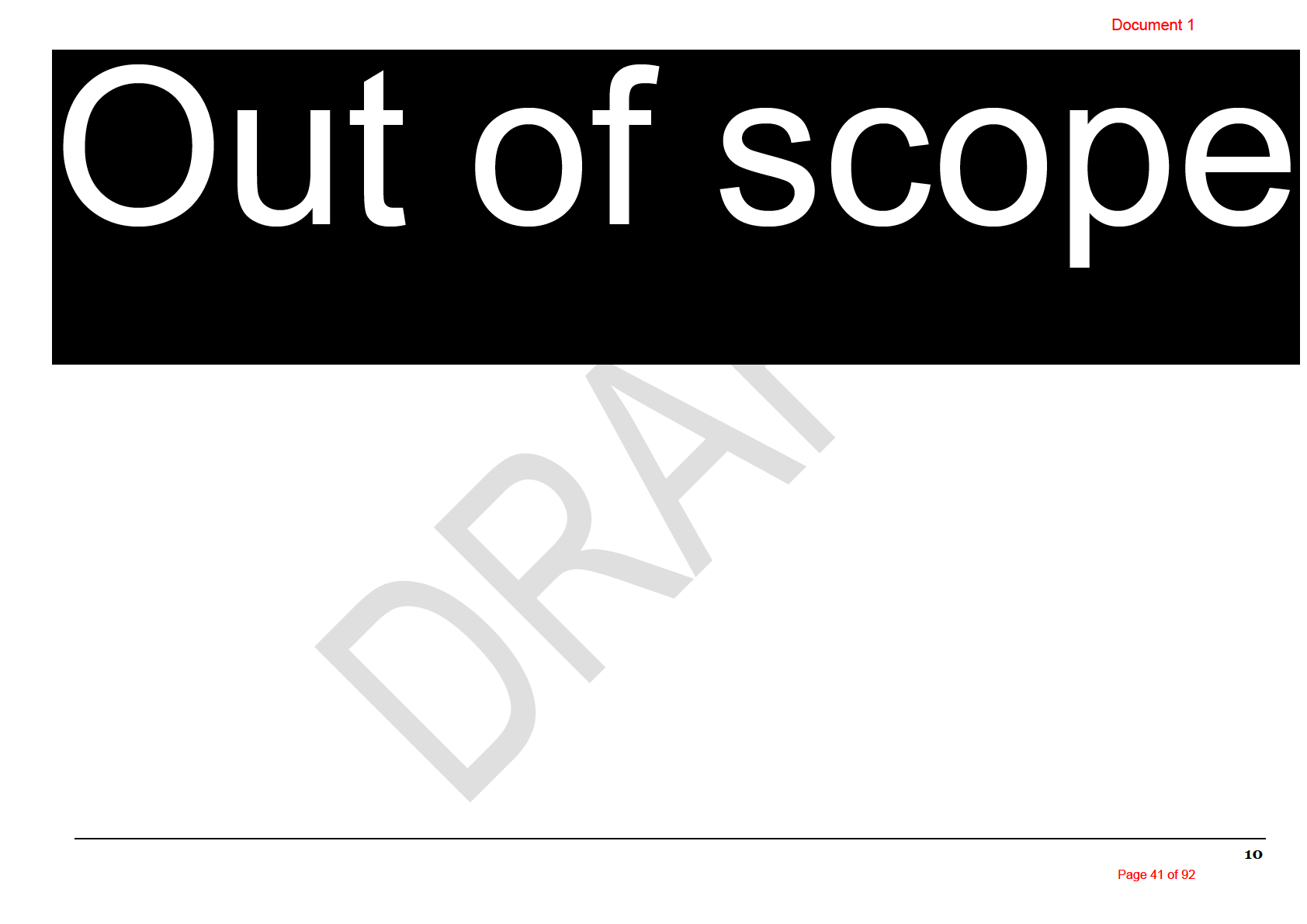
1982
ACT
INFORMATION
OFFICIAL
THE
UNDER
RELEASED
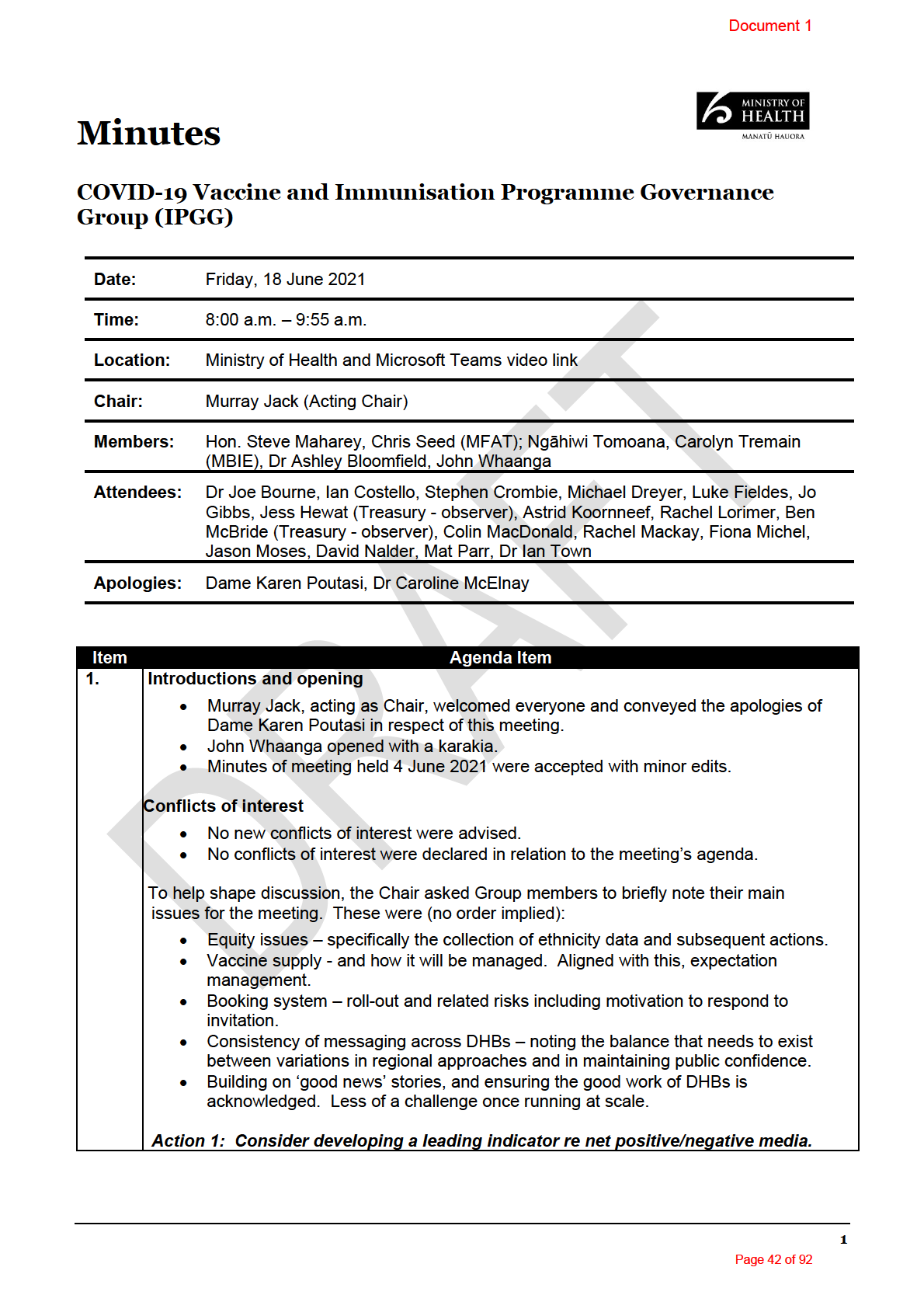
1982
ACT
INFORMATION
OFFICIAL
THE
UNDER
RELEASED
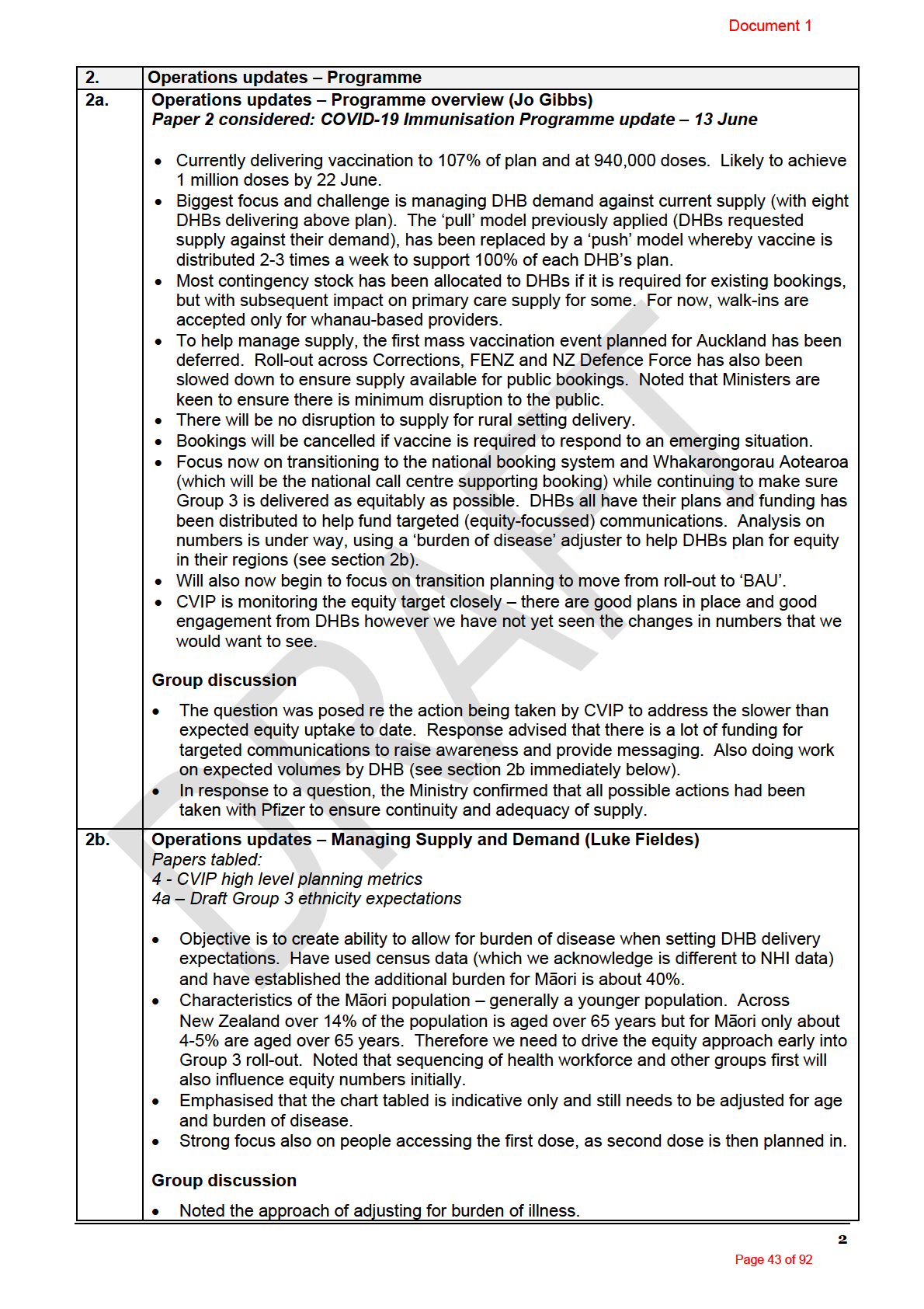
1982
ACT
INFORMATION
OFFICIAL
THE
UNDER
RELEASED
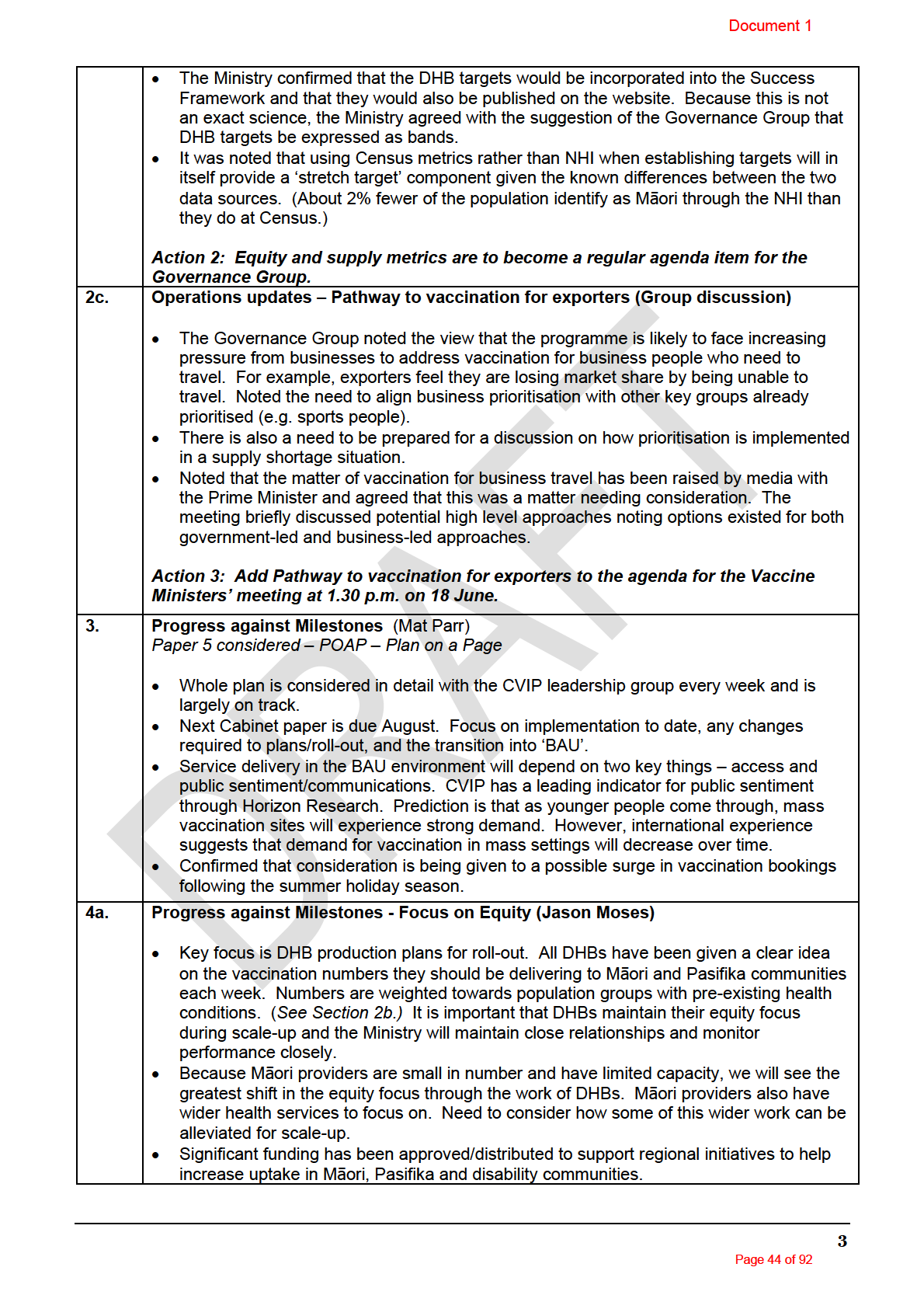
1982
ACT
INFORMATION
OFFICIAL
THE
UNDER
RELEASED

1982
ACT
INFORMATION
OFFICIAL
THE
UNDER
RELEASED
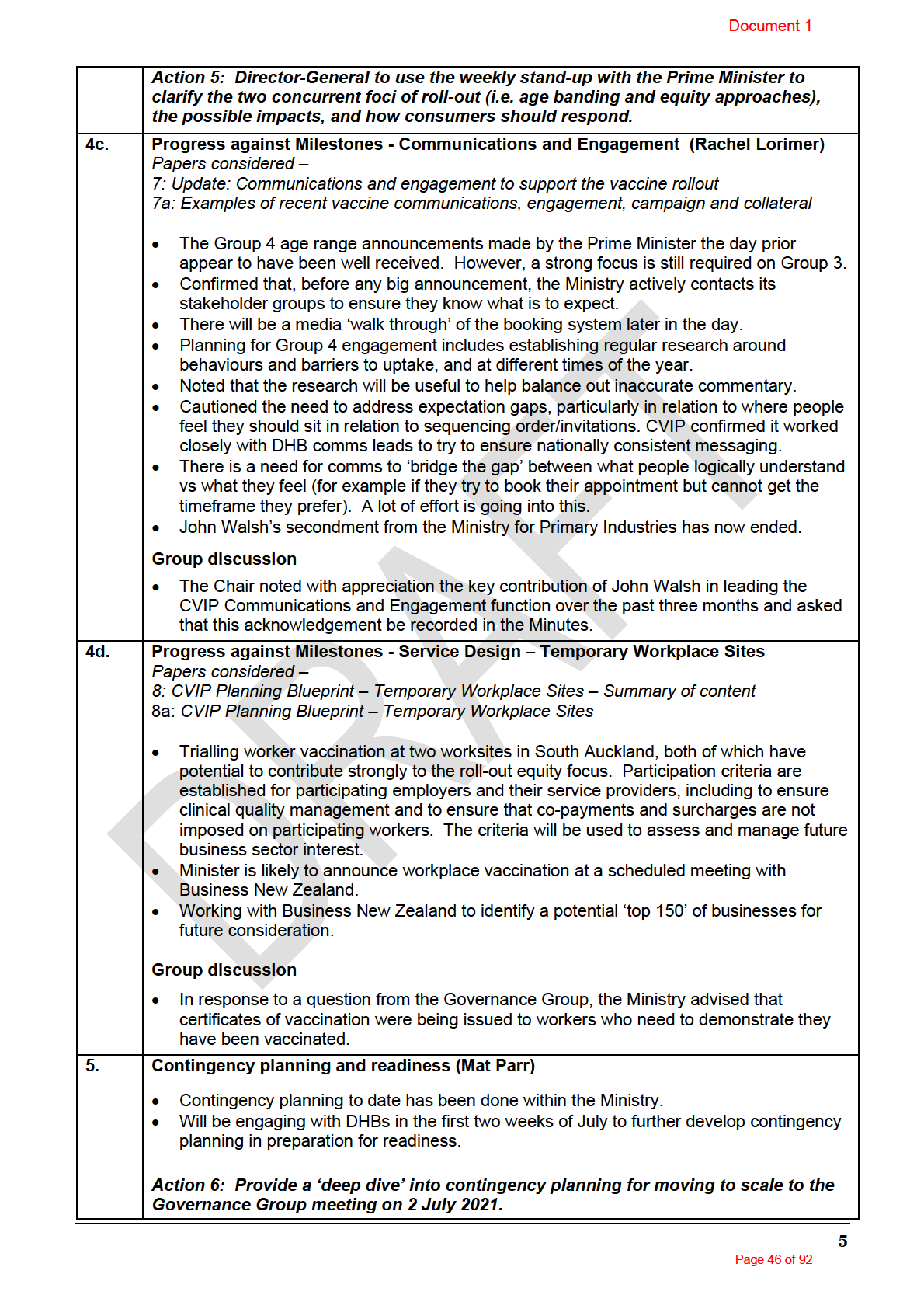
1982
ACT
INFORMATION
OFFICIAL
THE
UNDER
RELEASED
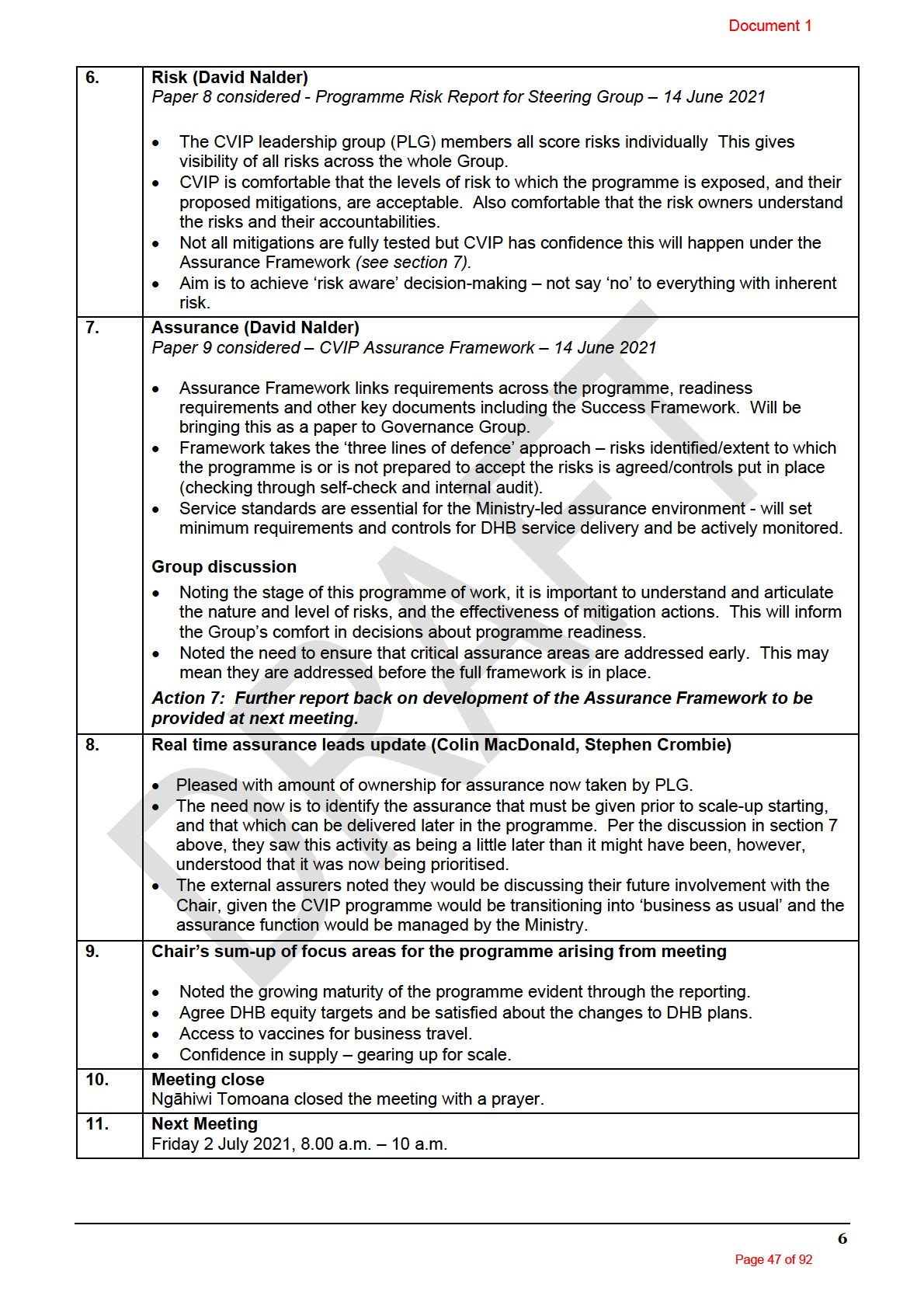
1982
ACT
INFORMATION
OFFICIAL
THE
UNDER
RELEASED
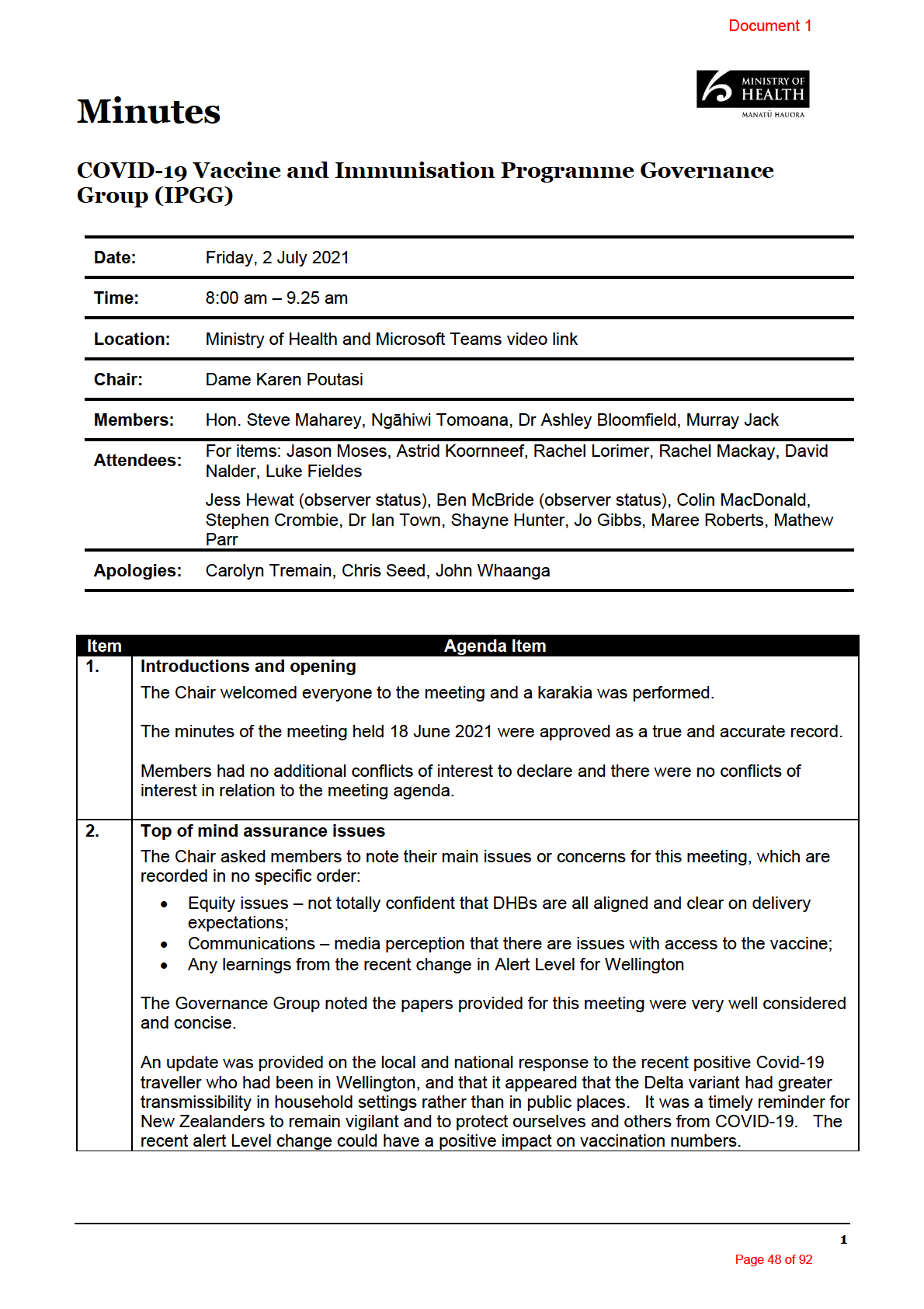
1982
ACT
INFORMATION
OFFICIAL
THE
UNDER
RELEASED
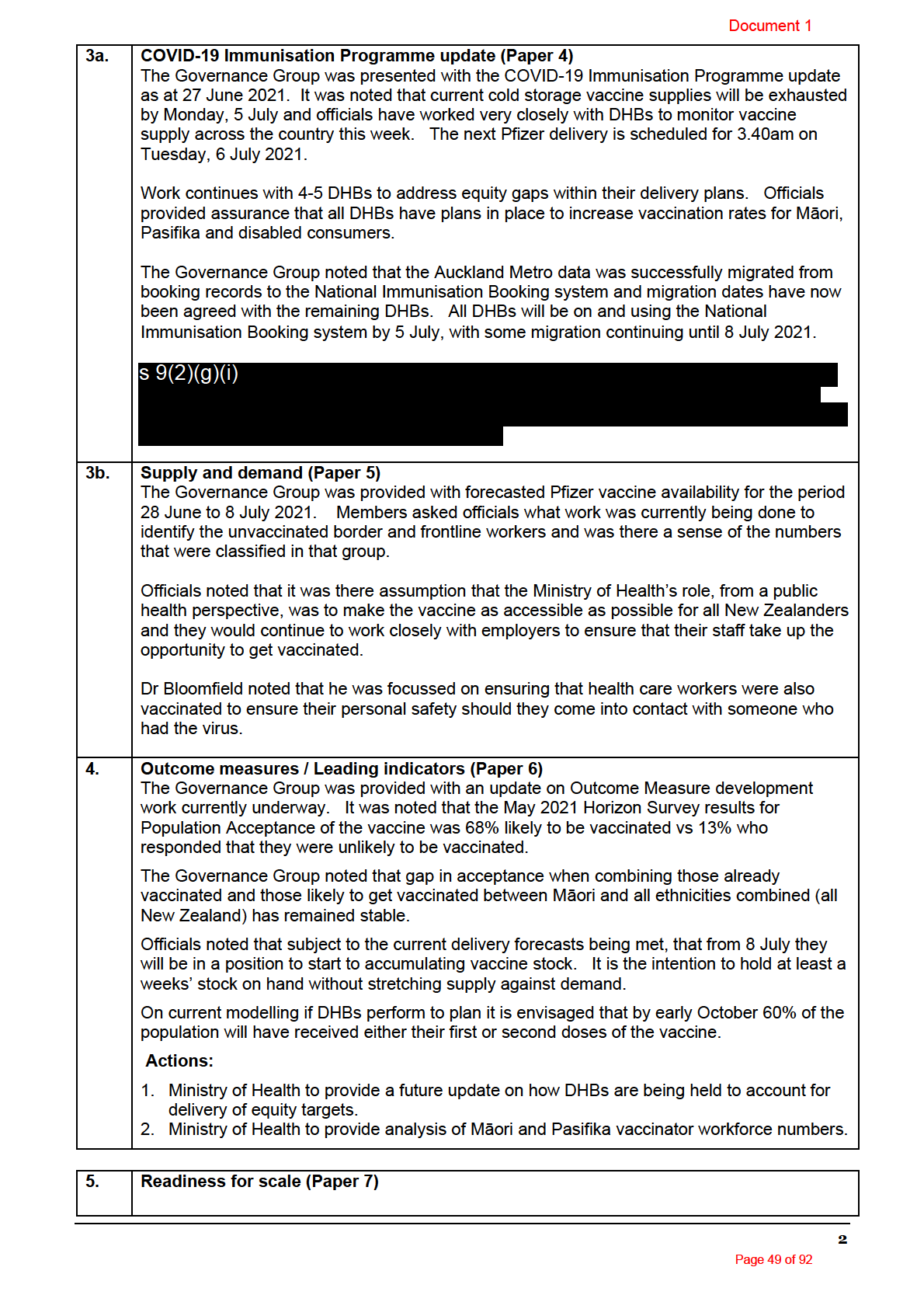
1982
ACT
INFORMATION
OFFICIAL
THE
UNDER
RELEASED
Document 1
The Governance Group was provided with an overview of the process for ensuring the rollout
of COVID-19 vaccinations across New Zealand is ready to scale for the scale and approach
needed for Group 4 (ie. open access to the general population). It was noted that the
Programme Leadership Team and the Steering Group had approved the readiness criteria
and that the Readiness to Operate at scale had been designed with equity, safety, experience
and efficiency success measures at the core.
Of icials noted that they were now in receipt of signed accountability documents from all
DHBs and National Providers and they were confident that there was good assurance with
clear accountability measures.
The Governance Group congratulated the team for the work completed with the assurance
framework, as it provided them with high confidence around the detailed assessment of
readiness.
1982
Dr Bloomfield acknowledged the considerable work that had been done to ensure a robust
and rigorous readiness assessment had been completed.
Actions:
ACT
1. Ministry of Health to provide at a future meeting any impacts the health reforms may have
on DHBs and how these can be mitigated to ensure that they do not impact on the
vaccination programme.
6.
Risk summary (Paper 8)
The Governance Group was provided with an update on the Covid Vaccine Immunisation
Programme risks and noted that the Programme Leadership Team were actively managing
any changes in risk ratings.
The Governance Group noted their confidence that management would continue
INFORMATION to manage
any risks identified in the programme.
7.
Contingency planning (Paper 9)
The Governance Group was provided with an update on contingency planning and noted the
recommendations of the Steering Group:
1.
Note that the PLG has identified six probable
OFFICIAL risk scenarios that would affect the
delivery of the expected national plan
2.
Note that the PLG has agreed to a phased development of contingency plans for the
identified scenarios THE
3.
Note that the CVIP Contingency Plans for the six scenarios have been completed
4.
Note that all DHBs have Business Continuity Plans in place as part of the readiness
criteria to go to scale.
5.
Note that a workshop wil be held on 1 July to further integrate the national (COVID-
19 Response Team
UNDER ), CVIP and DHB plans to the identified scenarios.
6.
Note that a contingency planning desktop exercise wil be conducted in mid July.
7.
Agree that the programme contingency plans be externally peer reviewed (e.g.
National Emergency Management Agency) as part of the overall Assurance Plan.
8.
Agree the Programme Director to engage with the Auditor General in relation to the
contingency planning recommendation contained in the “Preparations for the
nationwide roll-out of the COVID-19 vaccine”.
The Governanc
RELEASED e Group was briefed on the contingency workshop held on 1 July 2021 and
noted the scenarios, preventative and responsive measures that would be invoked. The
Governance Group noted their level of comfort with the work done to date on contingency
planning.
8.
Vaccine certification and consumer channel update (paper 10)
The Governance Group was provided with an update on the work being led by the Ministry of
Transport (MOT) and the Border Executive Board (BEB) to develop a digital COVID-19
3
Page 50 of 92
Document 1
Vaccination Certificate, which could be used as proof of vaccination for both workplace and
travel requirements.
Of icials led the discussion around the technology channels being explored and the intent to
ensure ease of use for consumers to access vaccination details, but also other health
records.
The Chair asked what steps were being taken to ensure equity of access for all New
Zealanders, and officials assured the Governance Group that due consideration would be
given to ensure equitable access to records.
9.
Realtime Assurance update
Stephen Crombie advised the Governance Group that this was his last meeting, as an
external auditor and it was his view that the Covid Vaccination Immunisation Programme was
1982
on the right path. The programme was delivering and the combination of having the strong
leadership, combined with the right people doing the rights things in a methodical manner had
the programme well positioned for success. Stephen Crombie acknowledged the Assurance
ACT
processes that had been put in place, as well as the great partnership between Operations
and Technology who have demonstrated a strong working relationship with a focus on
deliverables for the end user.
The Chair thanked Stephen Crombie for his contribution and the role that he had on the
Governance Group to provide real time assurance.
Dr Bloomfield echoed the sentiments of the Chair and noted that it would be beneficial to
capture and document the initiative to use a Governance Group as the benefits would be
measurable across many other government agencies.
INFORMATION
10.
Other business
Communications
The Governance Group was provided with an update from the Communications Group
Manager on current deliverables and resourcing. It
OFFICIAL was noted that the CVIP Communication
team worked closely with the DHB Communications teams to support them in delivering key
messaging locally in alignment with the national messaging. A Māori communications
strategy had just been signed off whi
THE ch would provide more guidance and confidence across
the programme. The strategy had been widely consulted with iwi and was currently with
Minister Henare’s office for his information. The Governance Group would be provided with
a copy in due course.
The Governance Group noted that there was stil some noise amongst media outlets with
UNDER
negative messaging and acknowledged the national and local efforts to mitigate negative
stories.
Actions:
1. Ministry of Health to provide a copy of the Māori communications strategy to Governance
Group in due course.
RELEASED
11.
Chair’s sum up of focus areas for the programme arising from meeting
The Governance Group members:
• Noted the programme was well positioned and looked forward to scale up and
readiness.
• The programme is well ahead of the game, congratulations to all on the work done to
date.
4
Page 51 of 92
Document 1
• Urged officials to seize the opportunity to capture the positivity around the programme
– things are being delivered.
• Confidence in management to identify and manage risks.
12.
Meeting close
The Chair closed the meeting at 9.25am, and asked Ngahiwi Tomoana to say a prayer.
The next meeting was scheduled for Friday, 16 July 2021 from 8.00am – 10.00am.
1982
ACT
INFORMATION
OFFICIAL
THE
UNDER
RELEASED
5
Page 52 of 92
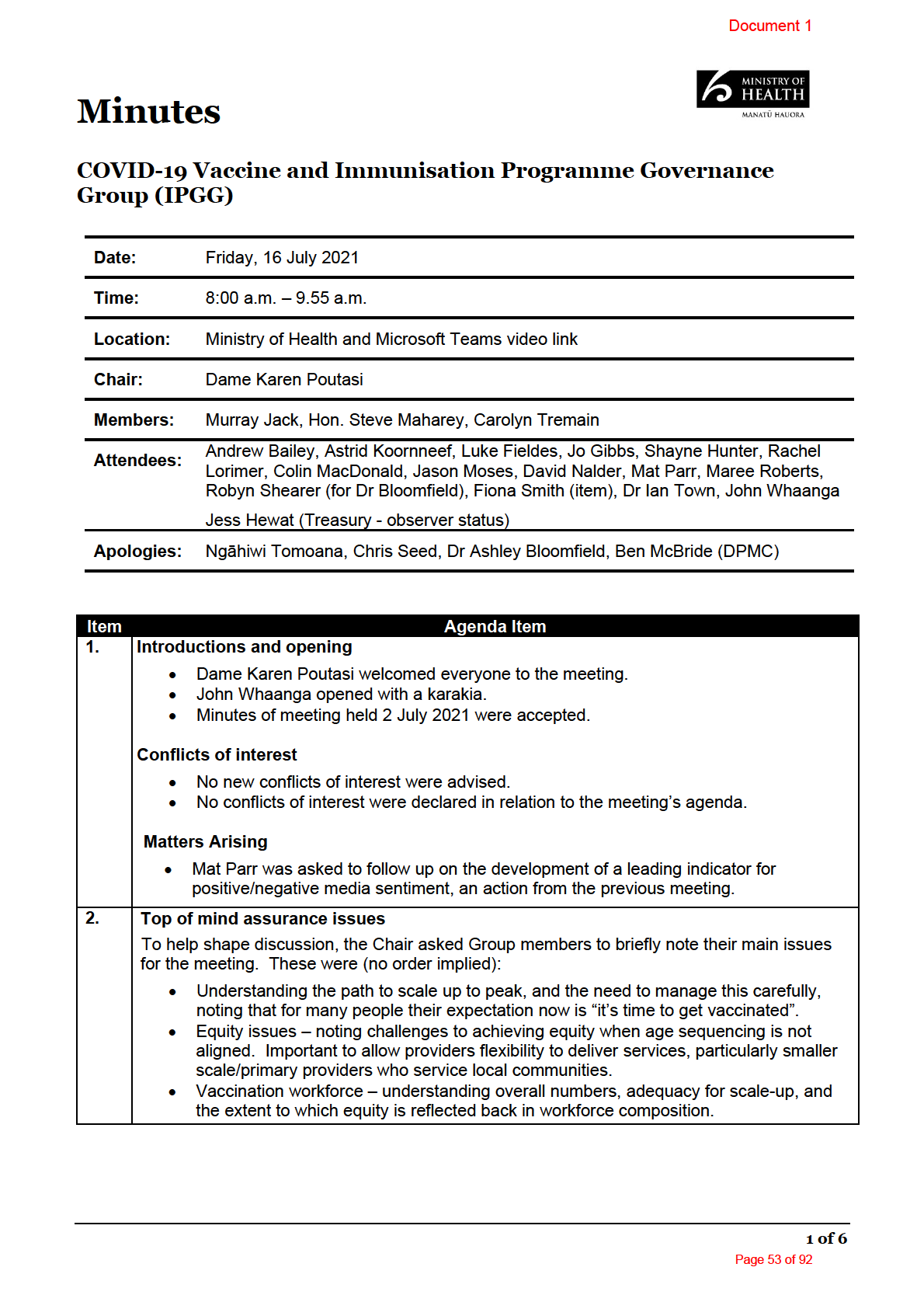
1982
ACT
INFORMATION
OFFICIAL
THE
UNDER
RELEASED
Document 1
3.
COVID-19 Immunisation Programme update (Jo Gibbs)
3a.
Paper 4 – COVID-19 Immunisation Programme Update – 11 July 2021
• The vaccine supply situation is stil tight. Two DHBs ran out of stock for a short period
whilst waiting for new supply to arrive from the hub.
• Situation is closely monitored. The quality and completeness of information held on the
Ministry’s portal about each DHB’s stock in hand is improving.
• Further vaccine supply due Tuesday 20 July. This will be distributed to service providers.
It will take some time to build up contingency stock. Situation should ease a bit towards
early August as larger shipments arrive.
• The national booking system is now live across all DHBs. Available vaccination slots are
viewable and bookable. Only some older bookings made by DHBs remain outside the
system and will be transferred manually.
Group discussion
1982
• The Governance Group noted that the ‘live’ status of the national booking system is likely
to remove a deterrent for many who prefer to make their own arrangements.
ACT
• The Ministry noted that the new challenge is to ensure that the forward capacity is loaded
(by the DHBs) into the booking system.
3b.
Communications and engagement –
general approach (Jo Gibbs/Rachel Lorimer)
• Al DHBs have commit ed to getting their Group 3 invitations out by 23 July. The Ministry
is monitoring this on a daily basis. The original commitment – Group 3 notifications out by
end June – happened substantially, but not entirely.
• Media messaging wil advise people aged over 65 years who haven’t received an
invitation of the number they can phone to book an appointment.
• The week of 23-28 July wil be a ‘hiatus’ to allow for reservations to take pl
INFORMATION ace. The
national call centre wil be open for five days from 17 July, but this wil only be announced
through local level communications to make sure that early call load is manageable.
• Whakarongorau has staffed up significantly and the Ministry is monitoring this to ensure
capacity meets demand.
• The Minister is likely to make the announcement to open to the first people in Group 4 on
28 July.
OFFICIAL
Group discussion
• The Governance Group noted a
THE change in the focus of comms from “we will contact you
about your vaccination” to “please contact us if you don’t have a booking”.
• The Governance Group also noted the need to manage expectations (consumer and
provider). Ideally all those in Groups 1, 2, and 3 wil be booked by end July.
• The Ministry agreed, advising:
• For consumers, the
UNDER ability to book online was unlikely to translate into an immediately
available vaccination slot, with waits of up to six weeks in some cases;
• For providers, there was a need for ‘tighter’ comms, depending on the provider’s
delivery model e.g. age band approach, whānau vaccination.
• Therefore the Comms campaign had two sets of messaging so that those identifying in
the system as Māori or Pasifika would receive a whānau invitation.
• Consumers were encouraged to book online, however, were also advised to phone in if
they prefer
RELEASED red to have their booking managed for them.
3c.
Invitation strategy – the sequencing/age banding approach
• Members of the Governance Group raised a number of issues about the sequencing
approach.
• Members noted the overlay of much of Group 3 with Group 4 and the comms and other
implications of this. They asked what criteria Ministers were working to when making
decisions re extension of the vaccination age bands. Criteria would better clarify the likely
2 of 6
Page 54 of 92
Document 1
implications of decisions, and support robust decision-making when deciding to launch a
new age band.
• The Ministry advised that the decision was made in June that Group 3 would be invited
across June to September 2021. This has not changed, however, with Group 4 roll-out
beginning, booking slot availability may come under pressure. Ministers are aware that
booking windows are 6-8 weeks out.
• This situation also has implications for comms and messaging (see section 3b).
Group discussion
• Members noted the differing approaches of some DHBs to approaching their Group 4
consumers. Where DHBs who do not extend invitations promptly after ministerial
announcement, this skews demand, and therefore also response. Lower response
volumes do not necessarily mean low interest. Members also noted consumer
perceptions risks from delay.
• Members were strongly of the view that criteria should be developed to inform sequencing
1982
decisions.
• Members suggested that sequencing and cohorts were really theoretical constructs and
potentially almost impossible to deliver on the ground. Addressing overlaps between
ACT
Groups 3 and 4 wil be problematic, particularly as service delivery moves out more widely
and into primary care. This diversity of delivery is good – but it provides challenges in
terms of expectations management.
Action 1: Ministry to consider developing decision criteria for sequencing. (Mat Parr)
4.
Outcome Measures/Leading Indicators (Luke Fieldes/Astrid Koornneef)
Paper screen shared – Operational Capacity for Tier 4 subgroups
• To help give us confidence in delivery, we need to understand how capaci
INFORMATION ty within the
booking system interfaces with DHB production plans.
• The chart shows how far through its delivery to a particular cohort any given DHB is when
Ministers make their next announcement. Currently quite significant overlaps can be seen
in many cases.
• DHBs can now see this data and are starting to gain an understanding of how they can
best use it.
OFFICIAL
• Having a better understanding of booking availability in relation to demand also:
o helps us to manage expectations, i.e. to frame up comms with those making
bookings;
THE
o can help Ministers to understand the system’s ability to support new age band
announcements at any given point.
• It can delineate by both first and second doses.
• Noted that the booking system does not currently include primary care. Projections
therefore include the primary care element stated within each DHB’s production plan.
UNDER
Projected bookings for primary care wil be refined as we gain more information into the
future.)
Group discussion
• The information provided is quite revealing in terms of the capacity in the system. The
issue is how this can be used to inform decision-making re opening up new cohorts.
• What level of flexibility does this approach have e.g. to report on activity within age groups
RELEASED
by particular DHBs?
5.
Programme Status (Andrew Bailey)
Paper 6 – COVID-19 Vaccination and Immunisation Programme Schedule Summary Update
12 July 2021
• This is a new report which aims to highlight the current status of each workstream,
providing a two-week view.
6.
DHB Accountability of equity targets (Jason Moses)
3 of 6
Page 55 of 92
Document 1
Paper 7 – Monitoring and Accountability Measures to support District Health Boards in
meeting Equity Targets
• A number of measures support DHB accountability for their equity targets.
• The equity data table (paper 7a) shows DHB actual and planned performance (for Māori
and Pacific peoples). There are some high performers, such as Capital & Coast and Hutt
Valley, where a recent vaccination event for Pacific people had been very successful
across both Māori and Pacific.
• However, the data table shows that whilst DHBs are able to achieve broad production
volumes, many are struggling with equity targets.
• The Ministry meets DHB SROs on a weekly basis to review performance.
General discussion
• The Governance Group noted that under an age-banded sequencing approach, Māori and
1982
Pacific populations will disproportionally come in the younger age bands.
• The suggestion was made that the programme think about ‘what attracts younger people
to get vaccinated?’ This is a wider question than just for Māori and Pacific
people.
ACT
o The Ministry noted that its research plan provides focus group information about
vaccination behaviour which informs messaging.
• Encourage flexibility in vaccination service provision by freeing up provider capacity from
other contractual obligations where possible. Ef ective vaccination is bigger than
administering the vaccine. Local providers are key connectors and have a comms role to
play. Al ow providers to create the right environment for their communities.
7.
Choices to support uptake and scale Q3 and Q4 (Mat Parr, Joe Bourne, Vince Barry)
Papers 8 and 8a – Q4 Strategy discussion – 12 July 2021
INFORMATION
• Previous modelling to reach ‘scale’ has been based on 70 per cent uptake.
• Research in New Zealand by Horizon shows that 80 per cent of people are now wil ing to
be vaccinated.
• A stretch ambition of 85% is therefore proposed for planning purposes.
• International experience shows there is an eight-week window of working at peak before
delivery starts to reduce. September and Octobe
OFFICIAL r are identified for focus in New Zealand.
• There are three settings possibilities to ‘push’ uptake:
o Through primary care settings;
o Through mass events;
THE
o Through schools (i.e. delivery to students, noting that school settings are already
being used by some DHBs as these provide a trusted site for e.g. whānau
vaccination).
• DHB production plans are signed off to end of September and will an increase for the
period post-August to del
UNDER iver the 85% ambition.
• Current planning was for around 800 vaccination sites. Significant effort is required to
onboard the necessary number of new sites to push fully into primary care (expected
requirement 2,000 sites).
Group discussion
• Messaging about supply needs careful consideration to reflect reality but retain
RELEASED
confidence. New supply has arrived but must stil be managed as the supply is not infinite
for some time yet.
• Messaging – including to Ministers – must be disciplined. Basically, wider roll-out has
started but we continue to need to manage supply so that we can meet demand.
Planning might include some mass vaccination events so that those eager to be
vaccinated have an earlier opportunity.
8.
Funding and Finance Update (Fiona Smith)
4 of 6
Page 56 of 92
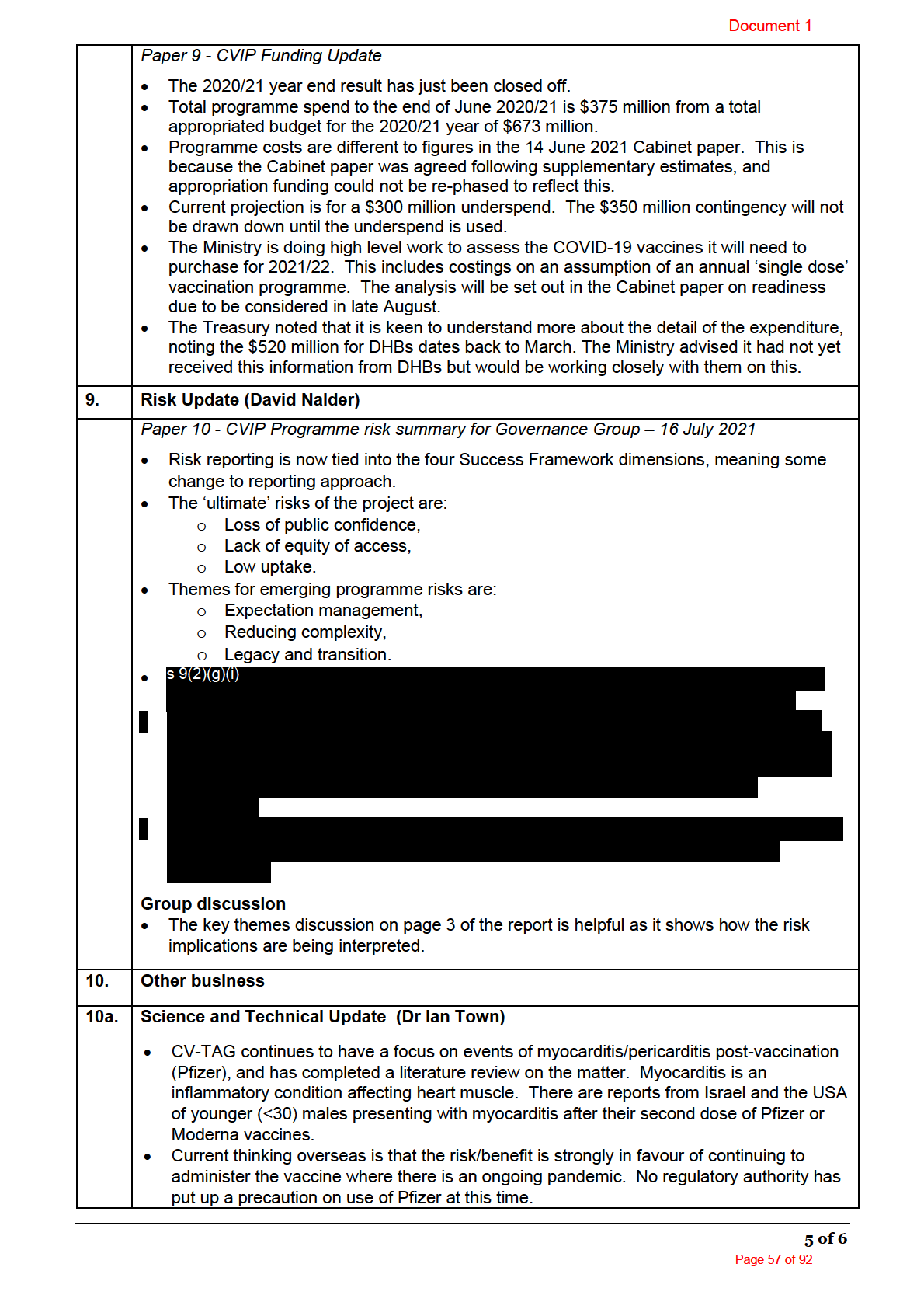
1982
ACT
INFORMATION
OFFICIAL
THE
UNDER
RELEASED
Document 1
• Questions to be addressed for the use of the Pfizer vaccine in New Zealand are:
o how this might impact on the use of the vaccine to 12-15 year olds and
o how Pfizer should be administered to ‘younger males’, e.g. those aged under 30
years.
• Advice is being prepared for the Director-General on these mat ers and wil be considered
at a future Steering Group meeting.
Group discussion
• In response to a question about Australia’s position on this matter, the Governance Group
was advised that the context in Australia is dif erent, however officials here would be
making contact with Australian officials to compare notes.
• In response to a further question regarding the use of other vaccines in New Zealand,
including Janssen, the Group was advised that a Cabinet paper was being prepared on
the future vaccine portfolio for New Zealand, for likely consideration mid-August. 1982
• Having more than one vaccine in the portfolio protects against the risk of supply chain
issues.
• As a single dose vaccine, Janssen may be a good alternative for those who cannot
ACT have
Pfizer due to side effects.
10b. Realtime assurance update
• Noted that this function had now ceased, with the programme assurance plan picking up
this activity. Colin MacDonald was now focusing on supporting the programme with
thinking around transition to the future state, and on CVIP legacy activity.
• The letter of thanks to Stephen Crombie was noted.
11.
Sum-up of Governance Group’s focus areas for the programme arising from meeting
INFORMATION
• Ensuring public communisations manage expectations around progress through Group 3
and the opening of Group 4.
• Invitation sequencing – consider developing criteria to help inform decision-making.
12.
Meeting close
The meeting ended at 9.55 a.m.
John Whaanga closed the meeting with a prayer.
OFFICIAL
13.
Next Meeting
Friday 30 July 2021, 8.00 a.m. – 10 a.m.
THE
UNDER
RELEASED
6 of 6
Page 58 of 92


















